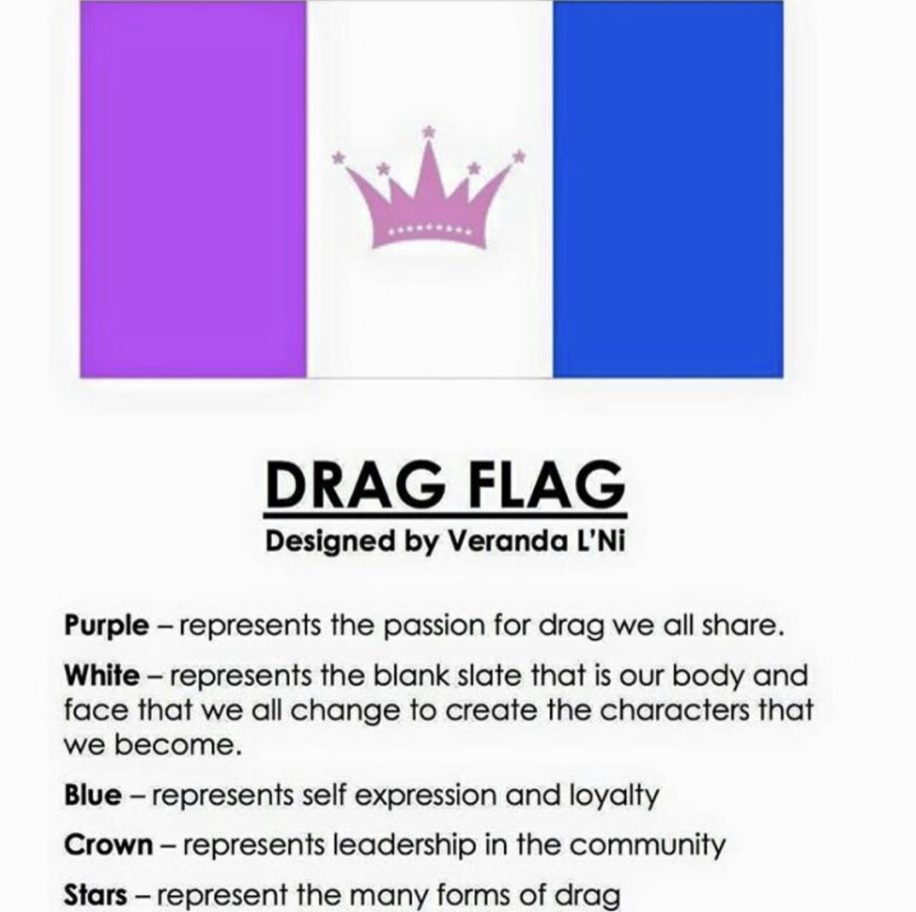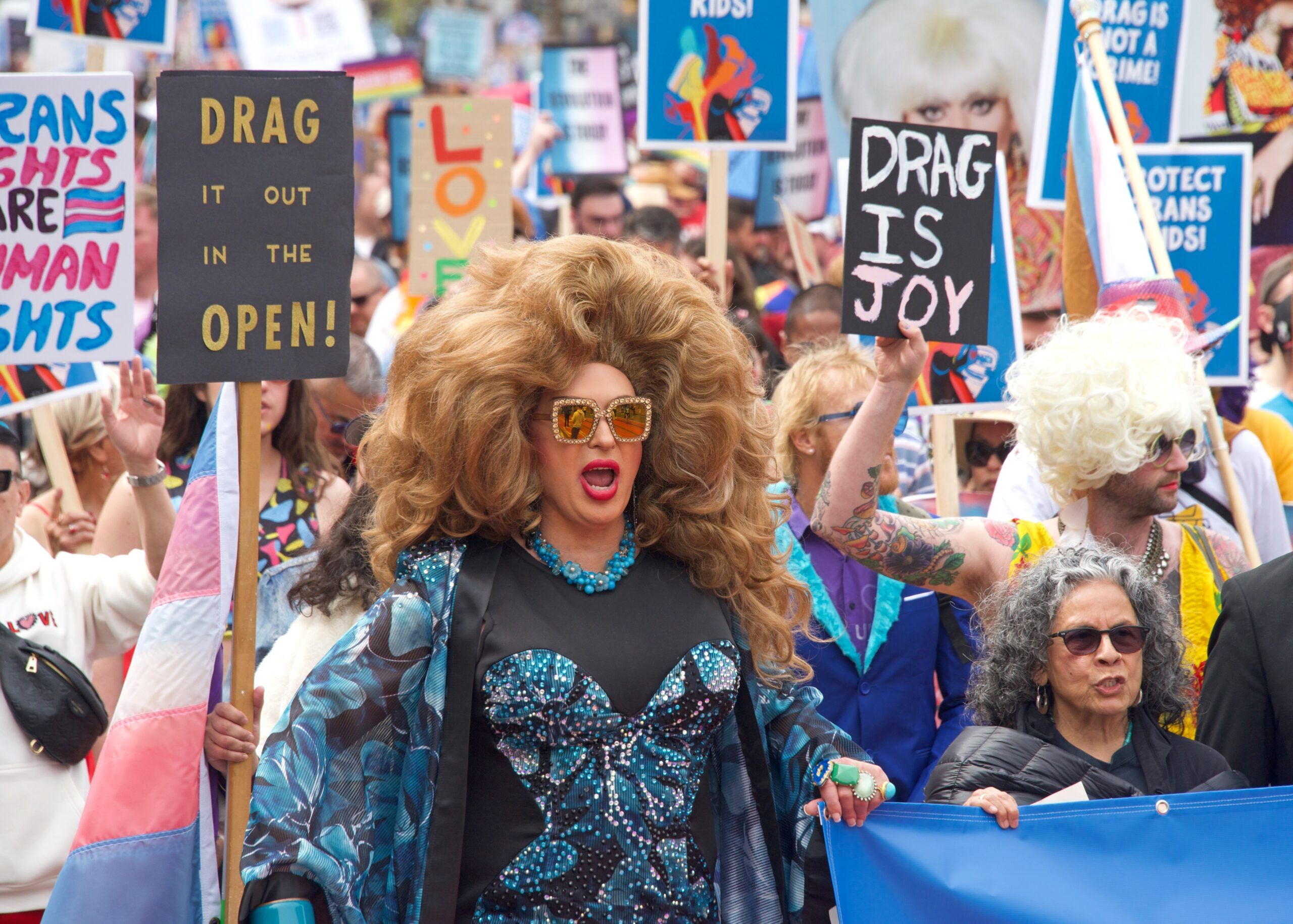The drag community has a rich history. The word itself refers to exaggerated femininity or masculinity and usually involves cross-dressing. For example a drag queen is usually someone who plays with exaggerated gender performance.
An important part of the drag community is the performance aspect. We can find camp, humor, and lip-syncing aspects sprinkled throughout a drag performance. The highly stylized personas that are born in the drag world make up a critical part of LGBTQ+ history.
In this article, we’ll explore what being drag means and how the history of drag culture is influential to the LGBTQ+ community. We will also delve into what it means to be a drag performer and how you might fit into the community.
Who is a part of the drag community?
Oftentimes people boil drag down to “a man dressed as a woman” but that is not what being a part of the drag community means. In fact that would just be considered cross-dressing. Drag as we know it consists of performance and over-stylized dressing which can include extravagant gowns or notorious heavy drag makeup. Someone who performs in drag also often has an alternate drag persona which might include a drag stage name and personality.
Although the majority of drag performers that are seen in mainstream media are male, there are many female drag performers as well. Females who perform in drag are called drag kings. A lot of drag kings touch upon the “macho” aspect of masculinity drawing on facial hair and wearing suits.
An important question we must touch on is “are drag performers transgender?” The answer is not always. Of course transgender people can perform in drag and drag does not require you to be of a certain gender identity. With that being said, being transgender is not a performance. Drag is a theatrical performance in which cross-dressing is involved, a drag performer comments on gender norms through expressing themselves with creative costumes and performances. On the other hand, transgender is a gender identity, which means they have possibly changed their pronouns, name, and undergone surgery to fit their gender identity. There is a stark difference between the two and the lack of understanding could be seen as transphobic. If you want to learn more about what it means to be transgender, find out here.
The History of Drag
The origin of drag performances date back to ancient Greece and Shakespearean times. The theatrical aspects we see today in drag takes root from men having to play women’s parts in plays because women weren’t allowed to perform.
A man by the name of William Dorsey Swann is known to be the “Queen of Drag.” A former slave who was freed after the Civil War, Swann was responsible for coining the term and the drag community itself. He started the very first drag house/family which in drag ball culture usually means sharing the same last name of the drag house or drag family they belong to and often living together, curating a supportive community. He was the catalyst of the drag movement.
We owe a lot of drag culture to the black drag queens that pioneered the performances we watch today. From vogueing to camp, queens of color were critical to the creation of what it means to be a part of the drag community and often fought racial and homophobic issues by expressing their gender identity. The queer liberation we see nowadays are due to those who stepped up despite drag performances being taboo and a crime. We have since seen drag performances become extremely popular in movies and TV such as shows like the Emmy Award-winning “RuPaul’s Drag Race,” and at queer bars and clubs.
In recent years drag performances have become very political. Certain individuals feel as though drag performances are “obscene” and “vulgar” and put it in the same category as adult entertainment. Many of those individuals want to restrict their children from interacting with drag queens as they don’t believe they are “family friendly.” This has led to a variety of drag bans such as the anti-drag law in Tennessee that has since been overturned for violating the First Amendment, which banned all “male and female impersonators” meant to end drag performances. Unfortunately, the fight for freedom is a routine part of drag history, but that doesn’t mean the LGBTQ+ community and allies aren’t fighting against this absurd news. From protesting to holding benefit concerts, we are trying to change history.
Related:
Graham Norton Says There’s an Unexpected Upside to the Drag Bans
Norton has good reason to believe right wingers are not up to the fight they’ve chosen.
Is drag for you?
Perhaps you aren’t sure if you want to join the drag community or if you might be a part of the LGBTQ+ community. Although we can’t tell you what your gender identity or sexuality is, we can provide some guidance:
Are you a performer?
If you like the idea of cross-dressing there might be a possibility that you would enjoy drag. With that being said it is important to note that drag is an art form that includes a performance aspect. If you like cross-dressing, but don’t enjoy extravagance and entertainment this might not be for you. Being a drag queen/king takes a level of talent and practice, you are performing and you have an audience. If this excites you, you may want to get involved with a drag family/house.
How do you express your gender identity?
The way you approach gender is a great tell tale of where you might fit in community wise. If you feel as though your gender identity does not correspond with the sex they were assigned at birth you might be transgender. Being a part of the drag community means you enjoy the art of gender expression through entertainment and performance. Being transgender or non-binary means you live an authentic gender identity, you are not “dressing up” or “performing” which is very different from the drag approach.
Drag queens/kings in the media
The drag community is growing now more than ever. The ebay way to delve into the drag community is to go to a local drag performance or event. There are many shows and performers you can watch and support. In addition there are various shows, movies and books that can help educate you on the drag community and we have included a couple below.
- The Queen: Documentary about the 1967 Miss All-America Camp Beauty Contest that introduced the world to competitive drag.
- We’re Here: A reality television series on HBO featuring former RuPaul’s Drag Race contestants Bob the Drag Queen, Eureka O’Hara and Shangela.
- Victor/Victoria: A movie about a singer and actress who finds success performing as a man. It was later adapted as a Broadway musical as well.
- Diary of a Drag Queen by Crystal and Tom Rasmussan: A book about the ins and out of the drag world. Shows you what it is really like to be a drag queen.
The drag flag

The drag pride flag was created at the Austin International Drag Festival (AIDF) in 2016. It has a crown and stars and three vertical stripes. The colors and symbols means as follows:
- Purple: represents a passion for drag.
- White: represents how one’s body and face become a blank slate to change and create characters on.
- Blue: self-expression and loyalty.
- The crown: leadership within the community.
- The stars: represents the many forms of drag.
Embracing identity diversity is critical
Drag history has always been a beautiful and colorful part of the LGBTQ+ community. We are forever grateful to those who pioneered and built the foundation of drag culture so that we might embrace diversity in public spaces. The art of performance and entertainment is evident in drag kings and queens. From extravagant costumes, to exaggerated makeup, and lip-syncing to Britney Spears, these individuals have explored gender identity in a whole new way.
If some of the ideas above resonate with you and you’re thinking of coming out, make sure the conditions are safe and have a plan of action regarding housing and food if things don’t go as planned.
Subscribe to the INTO newsletter to expand your understanding and awareness of our vibrant community
Don't forget to share:
This article includes links that may result in a small affiliate share for purchased products, which helps support independent LGBTQ+ media.
Help make sure LGBTQ+ stories are being told...
We can't rely on mainstream media to tell our stories. That's why we don't lock our articles behind a paywall. Will you support our mission with a contribution today?
Cancel anytime · Proudly LGBTQ+ owned and operated
Read More in Culture
The Latest on INTO
Subscribe to get a twice-weekly dose of queer news, updates, and insights from the INTO team.
in Your Inbox














